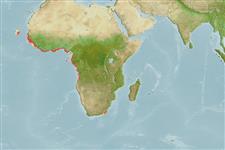>
Eupercaria/misc (Various families in series Eupercaria) >
Haemulidae (Grunts) > Haemulinae
Etymology: Pomadasys: Greek, poma, -atos = cover, operculum + Greek, dasys = with hair (Ref. 45335).
More on author: Cuvier.
Environment: milieu / climate zone / depth range / distribution range
Ecologia
marinhas; estuarina bentopelágico; intervalo de profundidade 25 - 90 m (Ref. 27000). Tropical
Eastern Atlantic: west coast of Africa, from Senegal to Angola (Ref. 57395). Also reported from Mauritania (Ref. 5377).
Tamanho / Peso / Idade
Maturity: Lm ? range ? - ? cm
Max length : 60.0 cm TL macho/indeterminado; (Ref. 57395); common length : 45.0 cm TL macho/indeterminado; (Ref. 2683)
Espinhos dorsais (total) : 12; Raios dorsais moles (total) : 15; Espinhos anais: 3; Raios anais moles: 10. Diagnosis: body oblong and compressed, rather elongate; head profile straight before nape; snout pointed, distinctly longer than eye diameter; 2 anterior pores on chin, followed by a median pit bearing openings of another pair of pores (Ref. 57395). 2nd anal fin spine usually shorter than 3rd (Ref. 57395, 81655). Caudal fin deeply forked; scales ctenoid; 6-7 scale rows between lateral line and middle of spinous dorsal-fin base (Ref. 57395). No pore above posterior end of maxilla and under preorbital bone (Ref. 81655).
Coloration: silvery with small dark spots forming a pattern of wavy lines on back and sides; fins greyish, dorsal black at base; a yellow-golden spot on snout (Ref. 57395).
Inhabits coastal waters (Ref. 2683, 57395) close to the bottom (Ref. 57395). Occasionally enters estuaries (Ref. 2135, 57395) and other brackish water areas (Ref. 57395).
Life cycle and mating behavior
Maturities | Reprodução | Spawnings | Egg(s) | Fecundities | Larvas
Oviparous, distinct pairing during breeding (Ref. 205).
Roux, C., 1990. Haemulidae. p. 783-788. In J.C. Quero, J.C. Hureau, C. Karrer, A. Post and L. Saldanha (eds.) Check-list of the fishes of the eastern tropical Atlantic (CLOFETA). JNICT, Lisbon; SEI, Paris; and UNESCO, Paris. Vol. 2. (Ref. 6946)
Categoria na Lista Vermelha da IUCN (Ref. 130435)
Ameaça para o homem
Harmless
Utilização humana
Pescarias: espécies comerciais
Ferramentas
Relatórios especiais
Descarregue XML
Fontes da internet
Estimates based on models
Preferred temperature (Ref.
123201): 18.5 - 25.8, mean 19.9 °C (based on 31 cells).
Phylogenetic diversity index (Ref.
82804): PD
50 = 0.5000 [Uniqueness, from 0.5 = low to 2.0 = high].
Bayesian length-weight: a=0.01318 (0.00701 - 0.02480), b=2.99 (2.83 - 3.15), in cm total length, based on LWR estimates for this species & Genus-body shape (Ref.
93245).
Nível Trófico (Ref.
69278): 3.6 ±0.50 se; based on food items.
Resiliência (Ref.
120179): Médio, tempo mínimo de duplicação da população 1,4 - 4,4 anos (Preliminary K or Fecundity.).
Fishing Vulnerability (Ref.
59153): Moderate vulnerability (44 of 100).
Nutrients (Ref.
124155): Calcium = 66.8 [14.7, 131.5] mg/100g; Iron = 0.731 [0.377, 1.420] mg/100g; Protein = 18.2 [16.4, 20.0] %; Omega3 = 0.226 [0.105, 0.399] g/100g; Selenium = 63.4 [33.2, 112.1] μg/100g; VitaminA = 26.9 [11.6, 60.2] μg/100g; Zinc = 1.31 [0.91, 1.88] mg/100g (wet weight);
